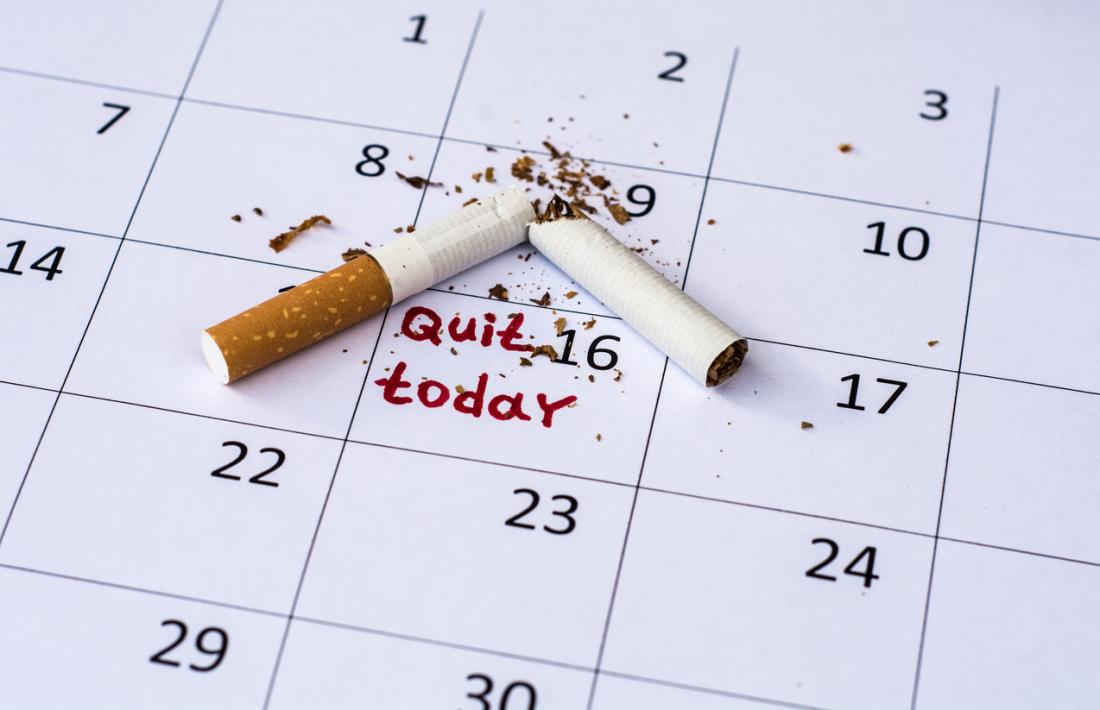Deciding that you are now ready to quit smoking is only half the battle. Knowing where to start on your path to becoming smoke-free can help you to take the leap. We have put together some effective ways for you to stop smoking today.
Tobacco use and exposure to second-hand smoke are responsible for more than
480,000 deaths each year in the United States, according to the American Lung Association.
Most people are aware of the
numerous health risks that arise from cigarette smoking and yet, "tobacco use continues to be the
leading cause of preventable death and disease" in the U.S.
Quitting smoking is not a single event that happens on one day; it is a journey. By quitting, you will improve your health and the quality and duration of your life, as well as the lives of those around you.
To quit smoking, you not only need to alter your behavior and cope with the withdrawal symptoms experienced from cutting out nicotine, but you also need to find other ways to manage your moods.
With the right game plan, you can break free from nicotine
addiction and kick the habit for good. Here are five ways to tackle smoking cessation.
1. Prepare for quit day
Once you have decided to stop smoking, you are ready to set a quit date. Pick a day that is not too far in the future (so that you do not change your mind), but which gives you enough time to prepare.
 Choose your quit date and prepare to stop smoking altogether on that day.
Choose your quit date and prepare to stop smoking altogether on that day.
There are several ways to stop smoking, but ultimately, you need to decide whether you are going to:
- quit abruptly, or continue smoking right up until your quit date and then stop
- quit gradually, or reduce your cigarette intake slowly until your quit date and then stop
Research that compared abrupt quitting with reducing smoking found that neither produced superior quit rates over the other, so choose the method that best suits you.
Here are some tips
recommended by the American Cancer Society to help you to prepare for your quit date:
- Tell friends, family, and co-workers about your quit date.
- Throw away all cigarettes and ashtrays.
- Decide whether you are going to go "cold turkey" or use nicotine replacement therapy (NRT) or other medicines.
- If you plan to attend a stop-smoking group, sign up now.
- Stock up on oral substitutes, such as hard candy, sugarless gum, carrot sticks, coffee stirrers, straws, and toothpicks.
- Set up a support system, such as a family member that has successfully quit and is happy to help you.
- Ask friends and family who smoke to not smoke around you.
- If you have tried to quit before, think about what worked and what did not.
Daily activities - such as getting up in the morning, finishing a meal, and taking a coffee break - can often trigger your urge to smoke a cigarette. But breaking the association between the trigger and smoking is a good way to help you to fight the urge to smoke.
On your quit day:
- Do not smoke at all.
- Stay busy.
- Begin use of your NRT if you have chosen to use one.
- Attend a stop-smoking group or follow a self-help plan.
- Drink more water and juice.
- Drink less or no alcohol.
- Avoid individuals who are smoking.
- Avoid situations wherein you have a strong urge to smoke.
You will almost certainly feel the urge to smoke many times during your quit day, but it will pass. The following actions may help you to battle the urge to smoke:
- Delay until the craving passes. The urge to smoke often comes and goes within 3 to 5 minutes.
- Deep breathe. Breathe in slowly through your nose for a count of three and exhale through your mouth for a count of three. Visualize your lungs filling with fresh air.
- Drink water sip by sip to beat the craving.
- Do something else to distract yourself. Perhaps go for a walk.
Remembering the four Ds can often help you to move beyond your urge to light up.
2. Use NRTs
Going cold
turkey, or quitting smoking without the help of NRT, medication, or therapy, is a popular way to give up smoking. However, only around
6 percent of these quit attempts are successful. It is easy to underestimate how powerful
nicotine dependence really is.
 NRTs can help you to fight the withdrawal symptoms associated with quitting smoking.
NRTs can help you to fight the withdrawal symptoms associated with quitting smoking.
NRT can reduce the cravings and withdrawal symptoms you experience that may hinder your attempt to give up smoking. NRTs are designed to wean your body off cigarettes and supply you with a controlled dose of nicotine while sparing you from exposure to other chemicals found in tobacco.
The U.S Food and Drug Administration (FDA) have
approved five types of NRT:
- skin patches
- chewing gum
- lozenges
- nasal spray (prescription only)
- inhaler (prescription only)
If you have decided to go down the NRT route, discuss your dose with a healthcare professional before you quit smoking. Remember that while you will be more likely to quit smoking using NRT, the goal is to end your addiction to nicotine altogether, and not just to quit tobacco.
Contact your healthcare professional if you experience dizziness, weakness, nausea, vomiting, fast or irregular heartbeat, mouth problems, or skin swelling while using these products.
3. Consider non-nicotine medications
The FDA have
approved two non-nicotine-containing drugs to help smokers quit. These are bupropion (Zyban) and varenicline (Chantix).
 Bupropion and varenicline are non-nicotine medications that may help to reduce cravings and withdrawal symptoms.
Bupropion and varenicline are non-nicotine medications that may help to reduce cravings and withdrawal symptoms.
Talk to your healthcare provider if you feel that you would like to try one of these to help you to stop smoking, as you will need a prescription.
Bupropion acts on chemicals in the brain that play a role in nicotine craving and reduces cravings and symptoms of nicotine withdrawal. Bupropion is taken in tablet form for 12 weeks, but if you have successfully quit smoking in that time, you can use it for a further 3 to 6 months to reduce the risk of smoking relapse.
Varenicline interferes with the nicotine receptors in the brain, which results in reducing the pleasure that you get from tobacco use, and decreases nicotine withdrawal symptoms. Varenicline is used for 12 weeks, but again, if you have successfully kicked the habit, then you can use the drug for another 12 weeks to reduce smoking relapse risk.
Risks involved with using these drugs include behavioral changes, depressed mood, aggression, hostility, and
suicidal thoughts or actions.
4. Seek behavioral support
The emotional and physical dependence you have on smoking makes it challenging to stay away from nicotine after your quit day. To quit, you need to tackle this dependence. Trying counseling services, self-help materials, and support services can help you to get through this time. As your physical symptoms get better over time, so will your emotional ones.
 Individual counseling or support groups can improve your chances of long-term smoking cessation.
Individual counseling or support groups can improve your chances of long-term smoking cessation.
Combining medication - such as NRT, bupropion, and varenicline - with behavioral support has been demonstrated to increase the chances of long-term smoking cessation by up to
25 percent.
Behavioral support can range from written information and advice to group therapy or individual counseling in person, by phone, or online. Self-help materials
likely increase quit rates compared with no support at all, but overall, individual counseling is the
most effective behavioral support method.
The National Cancer Institute (NCI) provide help to anyone who wants to stop smoking through their support services:
Support groups, such as Nicotine Anonymous (NicA), can prove useful too. NicA applies the 12-step process of Alcoholics Anonymous to tobacco addiction. You can find your nearest NicA group using their
website or by calling 1-877-TRY-NICA (1-877-879-6422).
5. Try alternative therapies
Some people find alternative therapies useful to help them to quit smoking, but there is currently no strong evidence that any of these will improve your chances of becoming smoke-free, and, in some cases, these methods may actually cause the person to smoke more.
Some alternative methods to help you to stop smoking might include:
 E-cigarettes have had some promising research results in helping with smoking cessation.
E-cigarettes have had some promising research results in helping with smoking cessation.
- filters
- smoking deterrents
- electronic cigarettes (e-cigarettes)
- tobacco strips and sticks
- nicotine drinks, lollipops, straws, and lip balms
- hypnosis
- acupuncture
- magnet therapy
- cold laser therapy
- herbs and supplements
- yoga, mindfulness, and meditation
E-cigarettes
E-cigarettes are not supposed to be sold as a quit smoking aid, but many people who smoke view them as a method to give up the habit.
E-cigarettes are a hot research topic at the moment. Studies have found that e-cigarettes are
less addictive than cigarettes, that the rise in e-cigarette use has been
linked with a significant increase in smoking cessation, and that established smokers who use e-cigarettes daily are
more likely to quit smoking than people who have not tried e-cigarettes.
The gains from using e-cigarettes may not be risk-free. Studies have suggested that e-cigarettes are
potentially as harmful as tobacco cigarettes in causing DNA damage and are
linked to an increase in arterial stiffness,
blood pressure, and heart rate.
Quitting smoking requires planning and commitment - not luck. Decide on a personal plan to stop tobacco use and make a commitment to stick to it.
Weigh up all your options and decide whether you are going to join a quit-smoking class, call a quitline, go to a support meeting, seek online support or self-help guidance, or use NRTs or medications. A combination of two or more of these methods will improve your chances of becoming smoke-free.









